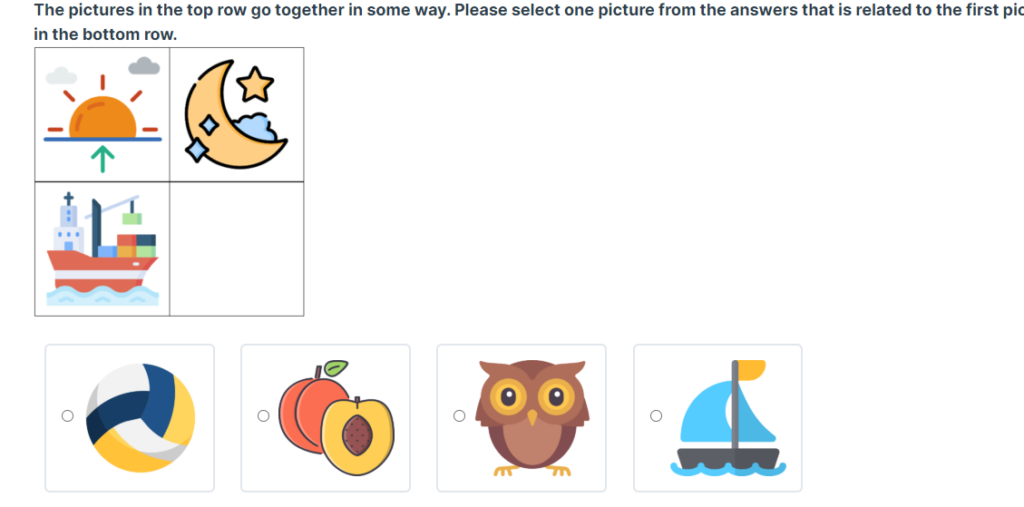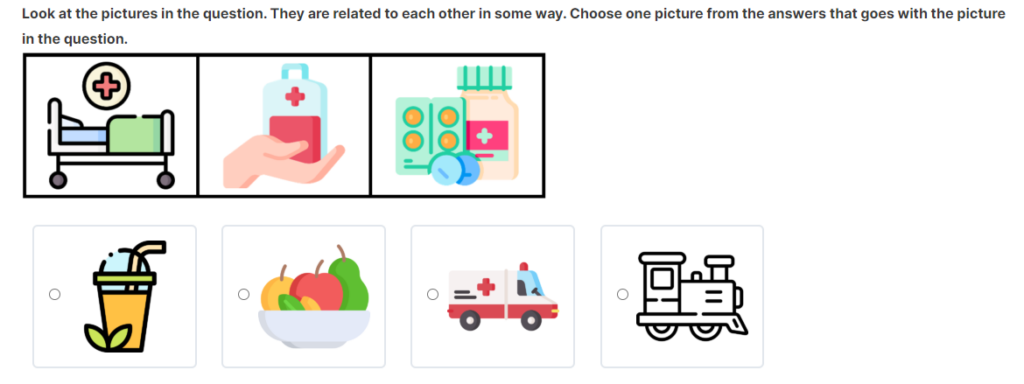The Verbal Battery is one of the three batteries that make up the Cognitive Abilities Test (CogAT). This battery assesses a student’s verbal abilities, including their vocabulary, verbal reasoning, and comprehension skills.
The Verbal Battery is composed of three subtests, which are Sentence Completion, Picture/Verbal Classification, and Picture/Verbal Analogies. At lower levels of CogAT, Verbal Analogies and Verbal Classification subtests rely on visual cues to evaluate students’ verbal abilities without requiring them to use their language skills. In the Picture/Verbal Classification subtest, students are presented with a set of images and must classify them based on a shared feature. The Picture/Verbal Analogies subtest requires students to identify relationships between sets of images and select an image that completes the analogy.
In the Sentence Completion subtest, the instructor reads a sentence that has a word missing, and students must select the most appropriate image to complete/match the sentence. This subtest measures a student’s vocabulary and their ability to use context to understand the meaning of words.
At higher levels of CogAT, specifically level-9 and above, students are expected to read individual words in the Verbal Analogies and Verbal Classification sections and complete sentences in the Sentence Completion section. This is designed to challenge their verbal abilities further and assess their comprehension skills more comprehensively.
Verbal/Picture Analogies
erbal Analogy is a component of the Cognitive Abilities Test (CogAT) that assesses a student’s ability to recognize and draw connections between words and concepts. This section of the test evaluates a student’s logical thinking and verbal reasoning skills. As students progress through different levels in the CogAT, the format of Verbal Analogy questions evolves to align with their cognitive development.
At lower levels of the CogAT, typically administered to younger students, Verbal Analogy questions are often presented in an image-based format. Students are shown pairs of images or pictures that have some sort of relationship. They are then asked to select the image from a list of options that bears a similar relationship to a given pair. For example, they might see an image of a sun next to a moon and need to choose an image that represents a similar relationship, such as a ship next to a boat.
Below is an example of a question designed for students at the lower levels of the CogAT.

As students advance to higher levels of the CogAT, typically given to older students, Verbal Analogy questions shift to a text-based format. Instead of images, students are presented with pairs of words or phrases that have a certain relationship, and they are asked to identify a word or phrase from a list of options that shares a similar relationship to the given pair. For instance, they might encounter a pair like “pen is to write” and be tasked with selecting a pair that follows a similar analogy, such as “knife is to cut.”
Verbal/Picture Classification
In the lower levels of the CogAT, typically administered to younger students, Verbal Classification questions are often image-based. Students are presented with a set of images or pictures that share certain characteristics or attributes. They are then asked to identify the image that does not belong to the group based on specific criteria. For example, they might see a group of images of animals and be asked to choose the image of a plant, which would be the one that doesn’t belong.
Below is an example of a question designed for students at the lower levels of the CogAT.

As students progress to the higher levels of the CogAT, which are typically administered to older students, Verbal Classification questions become text-based. Instead of images, students are presented with words or phrases that are related in some way. They are then required to identify the word or phrase that doesn’t fit into the category based on a set of rules or criteria. For instance, they might see a list of words like “dog,” “cat,” “rabbit,” and “bicycle,” and they would need to select “bicycle” as the word that doesn’t belong in the category of animals.
This transition from image-based questions to text-based questions reflects the increasing cognitive demands and the development of more abstract thinking skills as students progress through their education. Verbal Classification in CogAT is a valuable tool for educators and parents to assess a student’s ability to think critically, make logical connections, and categorize information effectively, which can be useful in tailoring educational programs to individual learning needs.

